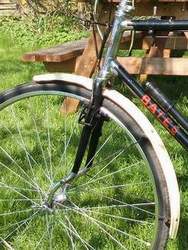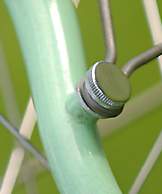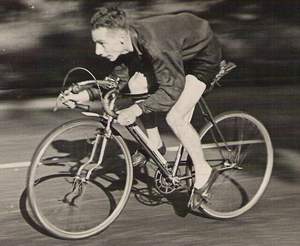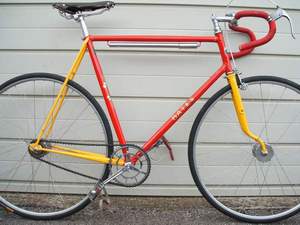Bates Cycles - Models and frame numbers
Posted: Monday 08th June 2020
This is by no means a comprehensive listing of the Bates models and variations. It is a guide based on available information only. If you have any Bates literature or information that may help in developing this section please get in touch with the webmaster.
The pre-war models
Horace Bates began building frames as early as 1926 and the first was named the Flying Bat. The Bat symbol has always remained a trademark of Bates cycles and is still present on their badging. One feature of many of their early frames was a chrome head tube and fairly plain head lugs featuring large rectangular windows into which the bat badge and model name was affixed. By 1934 Bates Brothers marketed a range of frames and complete lightweight cycles including track and time-trial machines.They also made tandems.

The year 1936 was a major turning point for Bates as this was when the new patented Cantiflex frame tubes and Diadrant front forks were introduced. This more rigid design with reduced flex was to prove a great success and it provided a marketing advantage over other lightweight cycle makers at a time when competition was fierce and the market growing rapidly. Bates soon earned a high reputation amongst racing cyclists on road and track.
In 1936, their all-chrome Volante road/path model weighed a mere 15½ lbs. Other models available in 1936 included the Vegrandis for the clubman and racing cyclist (new that year) and the Ideal, a clubman’s machine. The top road machine was the Utopian, a racing model weighing just 18lbs, presumably with sprints and fixed wheel. All of these featured the new Cantiflex 531 frame tubes and Diadrant forks along with chrome-plated head tubes and a choice of special finishes. Other models using conventional tubing were also produced by Bates at this time.
One feature of most Bates frames at this time was an unusually steep head tube angle (about 74deg) together with a long top tube. Bates called it their Ultavert design, a name given to the style rather than an individual model. The result was a more responsive machine with a short wheelbase. These features together with the light weight and great structural integrity very quickly established Bates cycles as a favourite amongst racing men.
The firm grew to accommodate a higher production rate but the quality remained, with each frame individually hand-built and finished. Low-temperature brazing techniques were employed for a stronger joint and the frames continued to be finished and filed by hand. It is often thought that cycles of this pre-war era were always finished in black or in dull colours yet this was far from the truth with lightweight cycles. Bates produced frames in any colour in plain enamel or ‘Cristolante’ – a kind of flamboyant or lustre – with chrome plating where desired. Enamelling and chrome-plating was carried out in-house to ensure high standards. These were really very attractive and eye-catching machines.

Even the Rigida mudguard eyes (another exclusive Bates design) were special – these were very neat and unobtrusive brazed-on fittings featuring a quick-release attachment. Initially they employed wing-bolt fastenings but later they used very attractive chrome-plated round-headed fittings. In the days when racing men rode to events on their cycles before removing mudguards and lights for the race, it was a useful and practical feature.
Most of the craftsmen who built the frames were racing men and, unlike many in the business, they were salaried rather than paid ‘piecework’, so there was no temptation to cut corners. One of these craftsmen was Stan Butler, a master frame builder who raced a Bates himself. After the war he went into partnership with Ching Allin to set up Allin cycles. Stan also built frames for the 1948 Olympic team. Another skilled frame builder at Bates was HR Morris, who later went on to build highly-regarded frames under his own name.
The catalogue for 1939 shows six different models plus the Grangewood tandem. All used Cantiflex tubing except for the New Club model (which used normal section Reynolds tubes) and all were available either as framesets or as complete machines.
By this time, the B.A.R model had been introduced as the top road model, reflecting the achievements on Bates frames in the Best All Rounder series. This was a prestigious title based on a combination of distance and time-trial events. The B.A.R was described simply as ‘the best bike you can get’ and it featured custom frame measurements (usually with 40 1/2 inch wheelbase) and a flam or standard enamel finish with chrome ends and a chrome head and fork crown, or to customers choice.
A look at the specification of the top-flite B.A.R road model gives us an insight into what the well-heeled road man of the day would have used in the late 1930s. The frame was of course Reynolds 531 throughout and it came with a Williams C1000 chainset (with hidden cotters if desired), Simplex Professional or Cyclo derailleur, Brooks B17 or Mansfield RR56 (alloy frame) saddle, Airlite small-flange hubs with alloy wingnuts and Constrictor sprint rims (or Sieber Star wood rims) wearing Dunlop tubs. It would have cantilever (Resilion) or Sieber alloy brakes, Rosalloy, Boa or Webb pedals. Bars and stem to choice. Despite being an out-and-out racing machine, this model came with Bluemel’s Noweight mudguards. The B.A.R cost just under £15 and weighed 22lbs (with gears). As a frameset complete with chainset and seatpin it cost £8 10s. The B.A.R was also available with the Sturmey Archer AR hub gear as used on the Lands End-John-o’-Groats record breaker.

The Vegrandis model was built to a similarly high spec except that this came with a single gear and had Dunlop Special Lightweight steel rims with British Hub Co ‘Solite’ hubs and Dunlop Sprite or High Pressure tyres. The heavier wheels no doubt accounted for the higher weight of 23½ lbs, but the cost was considerably less at £10.7.6. This model or the cheaper and less well equipped Ideal would have been more typical of the quality clubmens machines of the day, while the New Club model filled the niche for the less well-off rider. This did not use Cantiflex frame tubes but it did have Diadrant forks. It was more of a tourer with its longer 42in wheelbase and heftier weight of 26 lbs.
Also featured in the 1939 catalogue was the Volante track machine. This was always built to a rider’s individual spec and the quoted weight was ‘from 15lb according to specification’. Rudi Alt, three times Swiss champion, is pictured on his Bates Volante in the brochure.
Bates were certainly high-fliers in this immediate pre-war era and, back in production after the war ended, it was with a largely similar range of machines – when they could get the materials to make them. Frame angles became slightly less steep and top tubes shorter as a result, probably due to the type of lugs available at that time.

A Bates of London advertisement in a ‘Cycling’ magazine from 1950 describes their Volante track machine as ‘the leading track machine of the century – precision built and finished to your own specification’. Their cycles were advertised as ‘the perfect combination of lightness and rigidity’. The Volante, B.A.R and Vegrandis continued much as before, while a cheaper model was produced in normal Reynolds tubing under the names Vendome, Eucadian and New Club (at different times) . The Vendome model was reportedly produced in Belgium for a short period due to materials shortages in this country. Sales really took off in the early 1950s but by 1954 the boom period was over and the company had to rethink its future. Within a year it had closed all of its London branches and the firm was relocated to Westcliff-on-Sea in 1954.
The new home for Bates brought about a change of name to Bates of Westcliff and there were changes to the model range too. The Volante now featured quite fancy hand-cut lugs and was developed as a road model as well as for the track. The B.A.R model at this time was available in two versions with either the popular Nervex Professional or Nervex Legere series lugs. Nevertheless, production of all Bates models had slowed to a trickle compared with just a few years earlier. The manufacturing side of the business continued to dwindle over the years although both Cantiflex and 531 frames continued to be made in smaller and smaller quantities. Not much more than a hundred frames were built in the period between 1956 and 1963. The business at this time was really centred on the cycle shop rather than making frames.
In the mid-1970s a new catalogue showed the Volante with Nervex Pro or Legere lugs and Cantiflex tubing, while the Vegrandis and Eucadian were specified with conventional Reynolds 531 and the Vendome was produced in basic high tensile steel tube. Few were made during the 1970s and 80s, and yet somehow the Bates Cantiflex design has managed to survive and a Volante with feature-cut lugs, Cantiflex 531 tubes and Diadrant forks is still available more than seventy years after it first made its debut.
Model identification and frame numbering
Different models were sometimes given prefix or suffix codes. This was usually stamped onto the frame, sometimes not, so the model identifying code cannot be relied upon to be there. It’s possible that the prefix was used only for built up cycles rather than frames sold separately (or vice versa), or perhaps by certain frame builders but not others.
| Prefix | Model type |
| U | B.A.R. |
| VE | VEGRANDIS |
| VO / VOL | VOLANTE |
| EU | UTOPIAN |
| ED | EUCADIAN |
| I | IDEAL |
Frame numbering system
The frame numbering system used by Bates does not carry any code to denote the year or month of manufacture. It is purely sequential. The larger the number, the later the frame.
Some examples of frame numbers and year of manufacture:
| Frame Number | Year |
| U8827 | 31 May 1938 B.A.R. |
| 9788z | 1939 Bates Ideal |
| 010663 U | 1944 or 45 B.A.R (Bates Brothers) |
| V1E 15977 | May 1951 Vegrandis (Bates of London) |
| 17440 E | 1954 Vegrandis (one of the first built at Westcliff) |
| VO 17540 | 10 September 1954 |
| 17702 B | April 1956 B.A.R (Bates of Westcliff) |
| 17887 | 1958 Vegrandis |
There are full details of several built-up Bates in Readers’ Bikes
Thanks to Peter Underwood, Martin Coopland, Ray Etherton and Hilary Stone (Lightweight Cycles Catalogue Vol 1) for essential background material and sources of information used in researching this feature on Bates cycles.
Posted: Monday 08th June 2020
This article appears in the following categories.
Upcoming Events
Whether you are looking for a gentle social meet up, or a 100-mile ride browse the community’s upcoming events and plan your next weekend outing.
